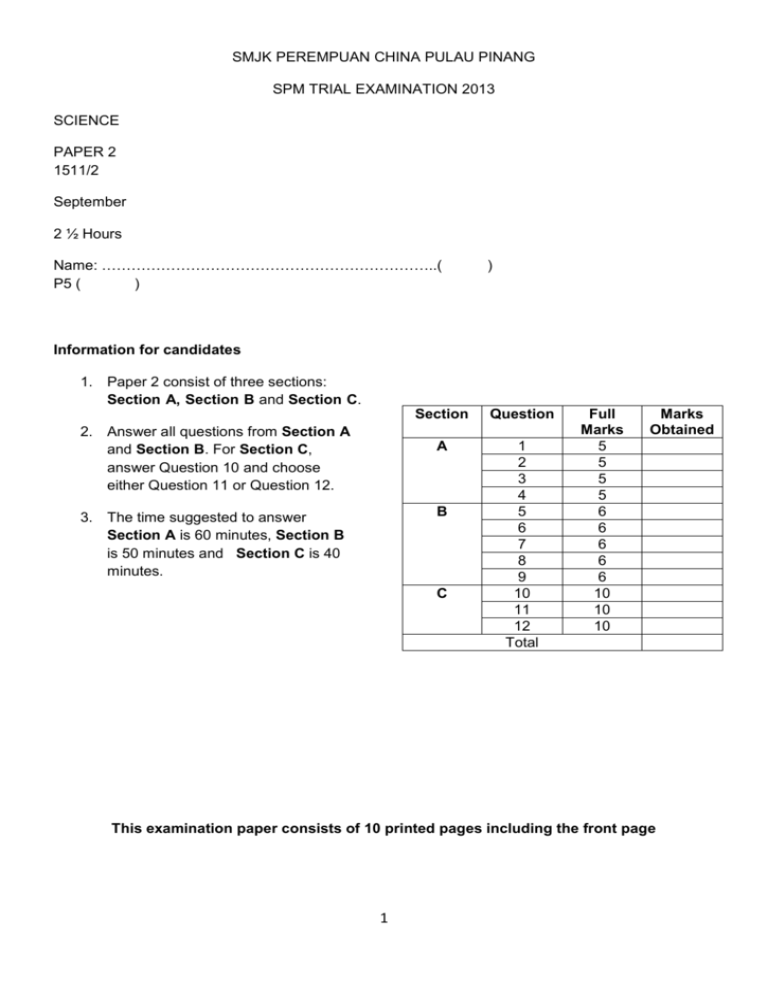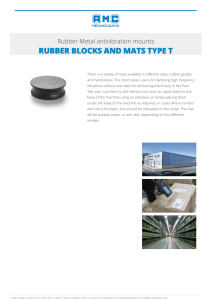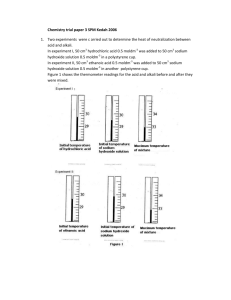SMJK PEREMPUAN CHINA PULAU PINANG
advertisement

SMJK PEREMPUAN CHINA PULAU PINANG SPM TRIAL EXAMINATION 2013 SCIENCE PAPER 2 1511/2 September 2 ½ Hours Name: …………………………………………………………..( P5 ( ) ) Information for candidates 1. Paper 2 consist of three sections: Section A, Section B and Section C. 2. Answer all questions from Section A and Section B. For Section C, answer Question 10 and choose either Question 11 or Question 12. Section Question A 1 2 3 4 5 6 7 8 9 10 11 12 Total B 3. The time suggested to answer Section A is 60 minutes, Section B is 50 minutes and Section C is 40 minutes. C Full Marks 5 5 5 5 6 6 6 6 6 10 10 10 Marks Obtained This examination paper consists of 10 printed pages including the front page 1 Section A [20 marks] Answer all questions 1. Diagram 1 shows an activity to study the formation of an image by using a convex lens. Object 2F F F 2F Diagram 1 a) In Diagram 1, draw a ray diagram to show the formation of the image. [2] b) Measure the heights of the image. _________________________ cm [1] c) State two characteristics of the image formed in 1 (a). _______________________________________________________________ _______________________________________________________________ [2] 2. Diagram 2.1 and 2.2 are used to study the electrical conductivity of lead (II) bromide in two different states. Diagram 2.1 Diagram 2.2 a) State one observation from Diagram 2.2. ______________________________________________________________ [1] b) Record the reading on both ammeters. P: ___________________A Q: __________________A [2] c) Give an inference for your observation of the ammeters. ________________________________________________________________ [1] d) State the operational definition of an ionic compound. ________________________________________________________________ _________________________________________________________________ [1] 2 3. A student cultures some bacteria, Bacillus subtilis in a Petri dish filled with nutrient agar. The Petri dish is placed in a cupboard kept at 36oC for six days. Table 1 is the data obtained by the student. Day Number of bacterial colonies 1 6 2 11 3 15 4 18 5 20 6 21 Table 1 a) Based on the data in table 1, plot a graph of the number of bacterial colonies against time. [2] b) State the variable i) ii) that is kept constant: ____________________________________________ that is responding _____________________________________________ c) [1] [1] What is the relationship between the number of bacterial colonies and time? _________________________________________________________________ _________________________________________________________________ [1] 3 4. Diagram 3 shows an experiment that is carried out to compare the properties of vulcanized rubber and natural rubber. Diagram 3 Rubber strip Q is immersed in sulphur monochloride solution for a few minutes before the experiment. The length of each rubber strip is measured before and after the experiment. The results of the experiment are shown in Table 2. Rubber strip Initial length of the strip/cm P Q 5.0 5.0 Length of the strip after adding the weight/cm 7.0 6.5 Elongation/cm Length after the weight is removed/cm 6.0 5.0 Table 2 a) Complete Table 2 to show the elongation of each rubber strip. [1] b) State the hypothesis of this experiment. _________________________________________________________________ [1] c) State the variables in this experiment. i) Constant variable: ________________________________________________ ii) Manipulated variable ________________________________________________ [2] d) Based on the results of this experiment, state the operational definition for rubber Q. ________________________________________________________________ _________________________________________________________________ [1] 4 Section B [30 marks] Answer all questions 5. Diagram 4 shows a cell undergoing division. Diagram 4 a) i) Name the type of cell division shown in Diagram 4. __________________________________________________________ [1] ii) Where does this type of cell division occur in a male? __________________________________________________________ [1] iii) State the importance of the cell division state in a) i). __________________________________________________________ [1] b) i) During state Y, the homologous chromosomes form in pairs near the equator and exchange genetic materials. Name the process. _____________________________________________________________ [1] ii) What is the effect of the process stated in b) i)? ______________________________________________________________ [1] iii) How do the daughter cells produced differ from the parent cell? ______________________________________________________________ [1] 5 6. Diagram 5 shows an unstable radioactive nucleus U-235 gradually changing into a more stable nucleus by emitting radioactive radiations P, Q and R. Diagram 5 a) Name process Y. _____________________________________________________________ [1] b) Based on Diagram 5, name the following radiations: i) P: _________________________________________ ii) Q: _________________________________________ iii) R: _________________________________________ [3] c) What is the effect of exposure to a small dose of radioactive radiation? ________________________________________________________________ [1] d) How is uranium-235 used to produce energy in a nuclear reactor? ________________________________________________________________ [1] 6 7. Diagram 6 shows an action that occurs when the toe of boy is pricked by a nail. Stimulation Impulse X Receptor Nervous system Muscle Response Diagram 6 a) Name the impulse pathway of the action that occurs. __________________________________________________________________ [1] b) Which nervous system is involved in this action? __________________________________________________________________ [1] c) What is nerve X that transmits the impulse from the receptor to the nervous system? __________________________________________________________________[1] d) Where does the transfer of impulse from nerve X to the nervous system occur? __________________________________________________________________ [1] e) State two other examples of action that is similar to that in Diagram 6. __________________________________________________________________ [2] 7 8. Diagram 7 shows the sequence of the stroke in the operation of a four-stroke diesel engine. Diagram 7 a) Name the substance drawn into the cylinder during stroke P. ___________________________________________________________________ [1] b) What is the function of structure Y in Diagram 7? ___________________________________________________________________ [1] c) What cause the piston to move downwards during stroke R? ___________________________________________________________________ [1] d) Name two substances that are pushed out of the cylinder during stroke S. ___________________________________________________________________ [2] e) State one difference between this diesel engine and four-stroke petrol engine. ___________________________________________________________________ [1] 8 9. a) Diagram 8 shows three different types of food that are preserved in three different ways, P, Q and R. Diagram 8 a) i) What is eliminated from the food through method R? __________________________________________________________ [1] ii) Why elimination is necessary through this method of food preservation? __________________________________________________________ [1] b) Food Q is heated at 121 oC. What is the purpose of heating? _____________________________________________________________ [1] c) Fresh milk shown in P is normally heated for 15 seconds. Suggest a suitable temperature that is normally used. _____________________________________________________________ [1] d) Suggest two other methods that can be used in food preservation. _____________________________________________________________ [2] 9 Section C [20 marks] Answer Question 10 and either Question 11 or Question 12 10. Study the following statement. A moving object with a high velocity has a big momentum. You are given two trolleys, two wooden blocks, a track, some plasticine and one more apparatus. (a) Suggest one hypothesis to investigate the above statement. [1] (b) Describe an experiment to test your hypothesis based on the following criteria: (i) Aim of the experiment [1] (ii) Identification of variables [2] (iii) List of apparatus and material [1] (iv) Procedure or method [4] (v) Tabulation of data [1] 11. (a) State four differences between pure metals and alloy. [4] (b) Diagram 9 shows various types of alloy. Brass Alloy Steel PppPolyv ynilstire ne Duralumin Diagram 9 Study the above materials and construct the concept of alloy. Your explanation about the concept should be based on the following aspects: (i) Identify two common characteristics. (ii) Construct the initial concept (iii) Give one example of another alloy and one example of non-alloy. (iv) State the actual concept [6] 10 12. (a) State four ways by which diseases caused by microorganisms are transmitted. [4] (b) The number of Dengue cases in Penang Island gradually increases. Explain how to prevent the transmittance of Dengue fever. Your explanation should include the following: (i) Identify the problem (ii) Clarification of the problem (iii) Suggest four methods to solve the problem. [6] END OF QUESTION PAPER PREPARED BY CHECKED BY CHENG L S 11 APPROVED BY










